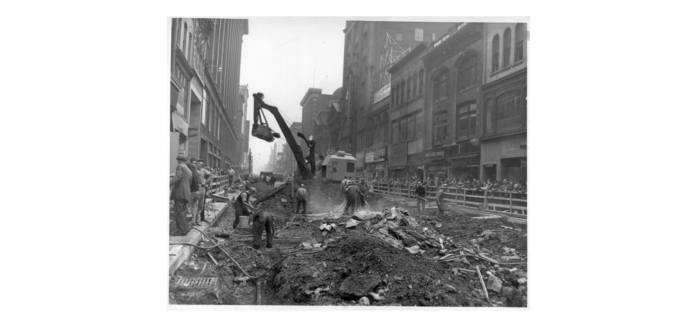
By Susanna McLeod
Special to Ontario Construction Report
The dust, the construction workers, the blasting-rumbling-crashing noise; it would all be worth the frustration in the early 1950s. Transportation in Toronto changed with the opening of the Toronto Subway System on March 30, 1954. As Canada’s first subway, it was a transit triumph.
As Toronto grew and sprawled, streetcar systems struggled to keep up with transportation needs. Discussions between politicians and stakeholders about a new system began before 1910. After disagreements, battles, problems, decades passed before the time was right. On Sept. 8, 1949, the celebration was a festive occasion with radio broadcasts, several thousand citizens, politicians, and Ontario’s Lieutenant-Governor, Ray Lawson. Pressing a lever, Lawson signalled the launch of the project with the sharp hammering of the pile driver.
Toronto’s first subway line started at Union Station, a north-south route running to Eglinton Avenue under Yonge Street. Twelve stations were set along the 7.4 km length.
Constructed mainly underneath busy Yonge Street, the work required a “cut and cover” method to prepare the roadway. “First, vertical steel piles were driven into the ground every six feet on each side of the street to provide support for the sides of the tunnel excavation,” said the City of Toronto website. Digging down from street level to the necessary depth, steel beams were placed horizontally, resting on top of the steel piles.
A surface was then created by laying 30 cm-square timbers across the beams. Foot traffic and automobiles could still travel. Streetcar track was laid down on the wood surface as well, so traffic could flow with little interruption. Utilities lines and pipelines were secured and protected.
Beneath the wood road a tumult of work progressed. Construction machinery excavated rock and dirt, loading it into dump trucks who used ramps to drive in an out of the site. Dynamite was used to blast immoveable rock into manageable size; in certain areas, workers used “picks and shovels so that gas and electricity lines and water and sewage pipes were not damaged,” described City of Toronto.
Moving away from the downtown area, portions of the subway route were “open cut,” not underground. Adding up to 2.25 km of the route, track was laid following the usual railroad procedures. Some homes were appropriated and torn down to make way for the line, and bridges were constructed for some roads crossing the subway path. Due to the Korean War, steel was in short supply, so bridges were formed of concrete with reinforced steel rods. The route crossed under railway tracks, so train service was undisturbed.
Lining the tunnel with concrete, “steel forms were built in twenty-foot sections mounted on a frame that rested on the floor,” said City of Toronto. “The forms could then be easily moved to the next area of the excavation.”
Stations were finished with paint and large tiles of opaque glass in light colours. Dark, narrow bands of colour were used at joints of ceiling and walls, and “each station had a different tile/band colour combination, so that passengers could easily recognize stations,” stated the City.
The project costs rang up to over $55 million in 1954 dollars. Using 28.2 tons of structural, reinforcing, and rail steel, the subway required 1.4 million bags of cement, said My TTC: Coupler. It required an enormous 170,000 tons of sand and 240,000 tons of gravel, plus more than 4.5 million metres of lumber.
The contract for 104 subway cars was awarded to Gloucester Railway Wagon & Carriage Co. Ltd. in late 1951. The firm in England presented a more affordable bid than manufacturers in Canada or the USA. On July 26, 1953, two train cars arrived from overseas, part of the “largest shipment of British-built rolling stock ever made to Canada,” stated My TTC. The beautiful red subway cars, Gloucester #5000 and #5001, were displayed at the Canadian National Exhibition a few weeks later.
Commuters flocked to the subway. Instead of taking an hour by streetcar, the subway made the one-way trip in just over 15 minutes at peak times. While streetcars shuttled 12,000 riders along per hour, “forty thousand an hour can be carried at peak periods on the underground at speeds up to forty-five miles an hour,” said John Clare in “The hectic story of Canada’s subway,” Maclean’s Magazine, July 19, 1958.
Among passengers riding the trains, independent kids enjoyed the subway experience. Their “idea of a day on the town is to ride the line until they become as much a part of the train as the two-man crew and until their mothers’ bulletins to come home are relayed to them on the public address system,” noted Clare.
Expansion lay ahead. The first extension began in 1959 and new lines continue to improve the system for efficient rider service. In 2020, the Toronto subway system operated 849 efficient cars.
© 2021 Susanna McLeod. McLeod is a Kingston-based freelance writer who specializes in Canadian History.
Suggested Image:
“Tearing up Yonge Street, Toronto, Ontario, to build the subway ca. 1950,” Library and Archives Canada. Retrieved from https://www.bac-lac.gc.ca/eng/collectionsearch/Pages/collectionsearch.aspx?q=toronto%20subway%20construction&DataSource=Images&
